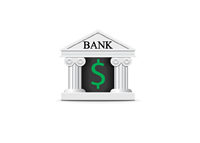How Does a Bank Make Money?
A question that I am often asked is - how does a bank make money?
Banks make money through 1) net interest income and 2) noninterest income. At your typical bank, net interest income will make up roughly 50-60% of total operating income, while noninterest income will make up the rest.
Net interest income is the difference between the income that banks earn lending out money and the interest payments that they have to pay out on their customers' deposits. Banks earn money by lending out the deposits that their customers have given to them. More deposits = more net interest income.
 Mortgages, construction loans, personal loans, commercial loans - interest earned on these "assets", minus the interest that is paid out on customer deposits, constitutes "net interest income".
Mortgages, construction loans, personal loans, commercial loans - interest earned on these "assets", minus the interest that is paid out on customer deposits, constitutes "net interest income". Noninterest income consists of all other fee-generating activities at a bank. This would include:
-monthly account fees
-online bill paying
-ATM fees
-securities brokerage commissions and fees
-investment banking
-insurance
According to the Federal Reserve Bank of New York, banks had a 56.6%/43.4% net interest income / noninterest income split in 2000.
Of the 43.4% in nonlnterest income, the majority (62.44%) was derived from "fees and other". The rest came from:
Service Charges - 15.2%
Fiduciary Income - 14.3%
Trading Revenue - 8.0%
--
It's interesting to note that noninterest income, as a % of total bank operating income, has surged over the past 30-40 years.
In 1970, noninterest income made up just 20% of the typical bank's total operating income.
By 2000, this number had jumped to 43.4%, thanks in large part to a jump in brokerage commissions and investment banking income, as well as the addition of new revenue streams such as ATM and online bill paying fees.
Source: Chicagofed.org - How do banks make money? The fallacies of fee income (*.pdf)
